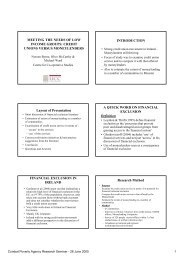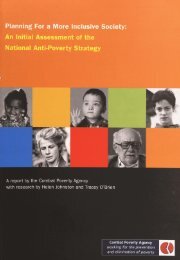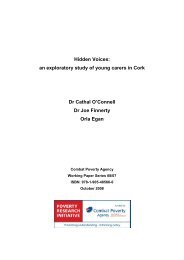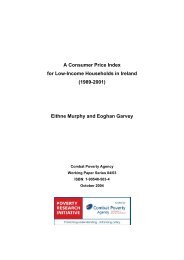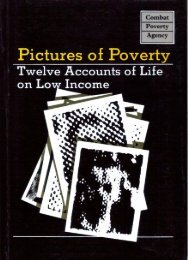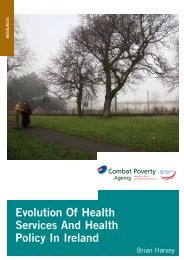The Distribution of Income in Ireland (2000) - Combat Poverty Agency
The Distribution of Income in Ireland (2000) - Combat Poverty Agency
The Distribution of Income in Ireland (2000) - Combat Poverty Agency
- No tags were found...
Create successful ePaper yourself
Turn your PDF publications into a flip-book with our unique Google optimized e-Paper software.
40 <strong>The</strong> <strong>Distribution</strong> <strong>of</strong> <strong>Income</strong> <strong>in</strong> <strong>Ireland</strong>samples for each <strong>of</strong> the years for which these are available. <strong>The</strong>HBS was carried out <strong>in</strong> 1973 and 1980, and although the microdatafrom these surveys are not available for analysis some figureshave been produced by the CSO, published <strong>in</strong> Murphy(1984, 1985) and Rottman and Reidy (1988). Table 4.5 shows thedecile shares <strong>in</strong> disposable <strong>in</strong>come among households from theHBS for 1973, 1980, 1987 and 1994/95. It also shows G<strong>in</strong>i and<strong>The</strong>il summary measures computed from these decile shares:while these will understate the extent <strong>of</strong> <strong>in</strong>equality at each po<strong>in</strong>t<strong>in</strong> time (because <strong>in</strong>equality with<strong>in</strong> each decile is ignored) theyshould capture trends over time adequately.Table 4.5: Decile Shares <strong>in</strong> Disposable <strong>Income</strong> among IrishHouseholds, 1973, 1980, 1987 and 1994/95 HBSDecileBottom234S6789TopAllG<strong>in</strong>i<strong>The</strong>il79731.73.35.06.57.89.210.913.016.226.4100.00.3670.221Share <strong>in</strong> Total Disposable <strong>Income</strong> (%)19801.73.55.16.67.99.311.013.016.225.7100.00.3600.21119872.23.75.06.37.69.211.013.416.625.0100.00.3520.2001994-952.13.54.86.07.69.211.313.616.725.1100.00.3620.210Source: Decile shares for 1973 and 1980 from Rottman and Reidy (1988), Table7.4, for 1987 and 1994/95 from microdata tapes (with correction for topcod<strong>in</strong>g).Look<strong>in</strong>g first at 1973 to 1980, we see that the share <strong>of</strong> the bottomdecile was unchanged but those <strong>of</strong> deciles 2-7 all rose slightly,with the top decile see<strong>in</strong>g a substantial decl<strong>in</strong>e <strong>in</strong> share. This isreflected <strong>in</strong> the fall <strong>in</strong> the G<strong>in</strong>i and <strong>The</strong>il coefficients, also shownTrends <strong>in</strong> <strong>Income</strong> <strong>Distribution</strong> s<strong>in</strong>ce 1973 41<strong>in</strong> the table. Between 1980 and 1987, the share <strong>of</strong> the bottomqu<strong>in</strong>tile rose substantially and that <strong>of</strong> the top decile aga<strong>in</strong> fell.Deciles 3-6 now experience a decl<strong>in</strong>e <strong>in</strong> share, however, withdeciles 8 and 9 see<strong>in</strong>g an <strong>in</strong>crease. <strong>The</strong> G<strong>in</strong>i and <strong>The</strong>il coefficientsshow a further decl<strong>in</strong>e <strong>in</strong> <strong>in</strong>equality between 1980 and1987. Over the whole period 1973-87, then, the HBS shows <strong>in</strong>equality<strong>in</strong> the distribution <strong>of</strong> disposable household <strong>in</strong>come fall<strong>in</strong>g,and the G<strong>in</strong>i coefficient fall<strong>in</strong>g from 0.37 to 0.35. This reflectsthe fact that the share <strong>of</strong> the top decile was down by 1.4per cent <strong>of</strong> total <strong>in</strong>come and that <strong>of</strong> the bottom qu<strong>in</strong>tile up by0.9 per cent. It is worth not<strong>in</strong>g that the other ga<strong>in</strong>ers were not <strong>in</strong>the bottom half <strong>of</strong> the distribution, but rather deciles 8 and 9. 2This pattern contrasts with the <strong>in</strong>crease <strong>in</strong> <strong>in</strong>equality observedfor gross <strong>in</strong>come, over both sub-periods and 1973-87 asa whole. <strong>The</strong> redistributive impact <strong>of</strong> <strong>in</strong>come tax and employees'social <strong>in</strong>surance contributions on the gross <strong>in</strong>come distributiontherefore <strong>in</strong>creased substantially over the period, asseen <strong>in</strong> the grow<strong>in</strong>g gap between the summary <strong>in</strong>equalitymeasures for gross and disposable <strong>in</strong>come. In 1973 the G<strong>in</strong>icoefficient for disposable <strong>in</strong>come was 97 per cent <strong>of</strong> that forgross <strong>in</strong>come, <strong>in</strong> 1980 it had fallen to 94 per cent, and by 1987 itwas only 88 per cent, while the correspond<strong>in</strong>g percentages forthe <strong>The</strong>il measure were 93 per cent <strong>in</strong> 1973, 87 per cent <strong>in</strong> 1980and 77 per cent <strong>in</strong> 1987. 3We saw <strong>in</strong> the previous section that the decl<strong>in</strong>e <strong>in</strong> <strong>in</strong>equality<strong>in</strong> the distribution <strong>of</strong> disposable <strong>in</strong>come between 1973 and 1987was not susta<strong>in</strong>ed after 1987. It would be desirable to look attrends dur<strong>in</strong>g the earlier period hav<strong>in</strong>g adjusted household <strong>in</strong>comesfor differences <strong>in</strong> size and composition, <strong>in</strong> other words toanalyse the distribution <strong>of</strong> equivalent household <strong>in</strong>comes.Without micro-data for 1973 and 1980, however, we have todraw on published results for those years. Roche (1984) presentedequivalent gross and disposable <strong>in</strong>come distributions2 In terms <strong>of</strong> Lorenz curves, 1980 and 1987 both Lorenz-dom<strong>in</strong>ate 1973. <strong>The</strong>Lorertz curve for 1987 lies <strong>in</strong>side that for 1980 at most po<strong>in</strong>ts, but those curvescross and there is no unambiguous dom<strong>in</strong>ance.3 Murphy (1984) and Rottman and Reidy (1988) note that between 1973 and1980 <strong>in</strong>equality rose even more for market <strong>in</strong>come — that is, <strong>in</strong>come beforecash transfers — but transfers <strong>of</strong>fset some <strong>of</strong> this <strong>in</strong>crease.




